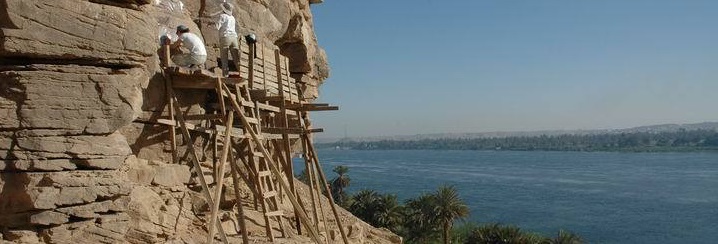El-Hosh
In March-April 2004, a Belgian-Egyptian team, sponsored by the Fund for Scientific Research – Flanders and directed by Dirk Huyge of the Royal Museums of Art and History in Brussels, continued rock art research at the sites of El-Hosh, on the west bank of the Nile, about 30 km south of Edfu. In addition to further recording, excavations were undertaken at several locations in order to find archaeological traces of the creators of the rock art. These activities led, amongst others, to the unexpected discovery of an intact tomb of the Naqada II period.
The rock art of El-Hosh has already been the subject of a survey organized in November 1998 (Huyge et al. 1998; Huyge 2000-2001). On that occasion a multitude of sites with thousands of petroglyphs was located. Attention was paid mainly to the oldest manifestations of rock art in the area representing intensively patinated, mushroom-shaped, curvilinear and geometric designs (including possible representations of labyrinth fish traps), as well as a number of seemingly associated anthropomorphic figures and zoomorphs. These drawings occur at three sites: Gebelet Jussef, Abu Tanqurah Bahari and Abu Tanqurah Qibli. At El-Hosh, it has been possible, for the first time in African rock art research, to obtain direct ages (termini ante quem) for the rock drawings on the basis of Accelerator Mass Spectrometry (AMS) 14C dating of organic matter enclosed in rock varnish [see Huyge et al.200; Huyge et al. 2002-2003]. The results indicate that part of the rock art at El-Hosh pre-dates the early 7th millennium BP 9mid 6th millennium cal BC), making it the oldest graphic activity thus far recorded in the Nile Valley.
Further surveying of the El-Hosh area in March-April 2004 has led to the discovery of several new rock art localities bearing an archaic repertoire of drawings. The most remarkable find, however, was a new petroglyph location at the southernmost tip of Abu Tanqurah Bahari. It shows several images of bovids executed in a ‘Franco-Cantabrian, Lascaux-like’ style. They are quite different from the stylized cattle representations in ‘classical’ Predynastic iconography of the 4th millennium BC. On the basis of patination and weathering, these bovid representations are definitely extremely old (possibly Late Palaeolithic or Early Neolithic?). They are comparable to similar bovid images that had been discovered in 1962-1963 on the opposite bank of the Nile, in the Gebel Silsila area (see Smith 1985).
With the intention to recover archaeological traces of the people responsible for the creation of the archaic rock art repertoire at El-Hosh, several soundings were made at the site of Gebelet Jussef. Three of the four soundings were made at shelter-like overhangs in the vicinity of rock art panels. Unfortunately, the shallow deposits in these shelters were thoroughly disturbed and no archaeological material was found in situ. The finds, mainly ceramics, indicate that the site of Gebelet Jussef was frequented throughout the Predynastic and early pharaonic periods. Traces of occupation phases which could be linked to the pre-7th millennium rock art repertoire, however, were not found.
In addition, a number of circular stone structures were investigated at the southern extremity of Gebelet Jussef. On the basis of the rough ceramics found in and near these constructions, these are probably ‘Bedouin’ and/or ‘Nubian’ in nature. Their function and age remain unknown. Below one of the structures, but evidently unrelated to it, an intact tomb was found, dug into the bedrock. This tomb is clearly of Naqada IIC age (c. 3500-3400 BC) and contained a skeleton and a number of grave goods including two small Rough jars, two large Red-Polished bowls and a superb Decorated vase. The latter item is decorated with boats, human figures and birds. The deceased faced west and was buried in a contracted position, the hands covering the face. Below the skeleton lay several well preserved fragments of a reed matting. According to a preliminary anthropological analysis (by Dr. Caroline Polet) the skeleton is probably that of a female aged between forty and fifty and with a stature of about 1.55-1.60 m. It is currently unknown whether or not this tomb indicates the location of a Naqada II cemetery.
References
- D. Huyge, M. De Dapper, D. Depraetere, M. Ismail, E. Marchi, R. Mommaerts, I. Regulski and A. Watchman, Hilltops, Silts, and Petroglyphs: ‘The Fish Hunters of El-Hosh (Upper Egypt)’, Bulletin van de Koninklijke Musea voor Kunst en Geschiedenis/Bulletin des Musées royaux d’Art et d’Histoire 69 (1998), 97-113.
- D. Huyge, ‘Rock Art Research in Upper Egypt: The Environs of El-Hosh. Report on the work done in 1998’, Annales du Service des Antiquités de l’Egypte 76 (2000-2001), 45-52.
- D. Huyge, A. Watchman, M. De Dapper and E. Marchi E., ‘Dating Egypt’s Oldest ‘Art’: AMS 14C Age Determinations of Rock Varnishes Covering Petroglyphs at El-Hosh (Upper Egypt)’, Antiquity 75 (2001), 68-72.
- D. Huyge, M. De Dapper, E. Marchi and A. Watchman, ‘Les chasseurs de poissons d’El-Hosh (Haute-Egypte): l’art rupestre le plus ancien de la vallée du Nil’, in J. Polet (dir.), Afrique: Archéologie & Arts 2 (Paris, 2002-2003), 39-46.
- P.E.L. Smith, ‘An Enigmatic Frieze from Upper Egypt : A Problem in Nilotic Rock Art’, in M. Liverani, A. Palmieri and R. Peroni (eds), Studi di paletnologia in onore di Salvatore M. Puglisi (Roma, 1985), 359-368.

